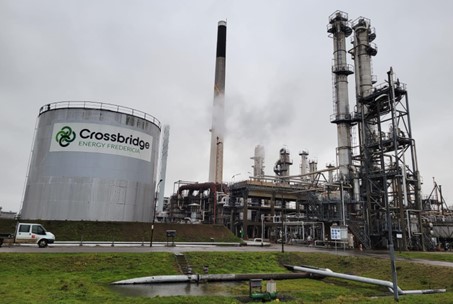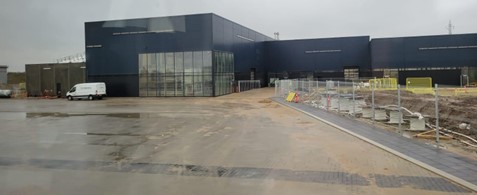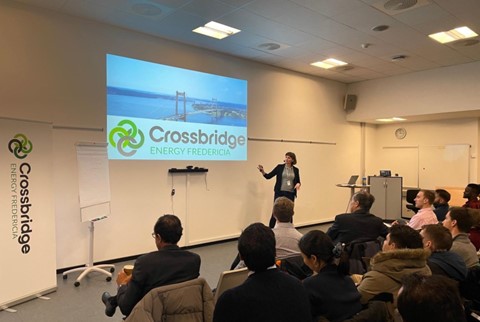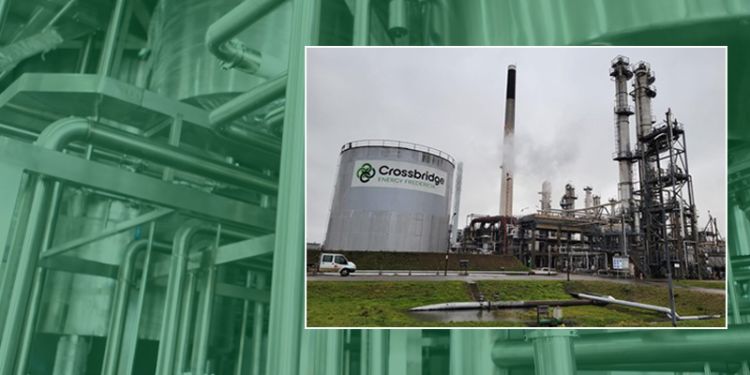In January 2023, Professors Willy Shih and Mike Toffel led more than 40 HBS MBA students on site visits to witness the energy transition and innovative sustainable production activities throughout Denmark and the Netherlands, in their new Immersive Field Course (IFC). This is one of 13 student essays posted on the HBS Business and Environment Initiative’s Blog that highlights their reflections. Learn more about this IFC course on Decarbonization and Sustainable Production by watching this five minute video summary.
Visit Date: January 4, 2023
As part of the Decarbonization and Sustainable Production immersive field course, we met with the HySynergy-Crossbridge Energy partnership that was created to produce liquid e-fuels in Fredericia, Denmark. Many of the companies we visited in Denmark and the Netherlands emphasized investment time-lags and the “chicken-and-egg” problem that challenged efforts to transition to a “greener” economy, and this site provided a stark example of energy transformation in process. The Crossbridge Energy refinery was acquired from Royal Dutch Shell by American private equity (PE) firm Postlane Partners, and supplies 35% of Denmark’s fossil fuels. HySynergy, which is backed by the publicly traded company Everfuel, has completed the first of a three-phase investment in hydrogen electrolyzers—a fundamental Power-to-X technology—designed to support the refinery’s transition to e-fuels.
What inspired and surprised us
HySynergy has committed to energy production targets in the nascent hydrogen market. Our visit to Crossbridge Energy provided clarity on the usage as well as the financial and sustainability aspects of these production targets. HySynergy’s clever use of long-term supplier agreements and constructing its facility on a site adjacent to Crossbridge Energy’s refinery enables the site to benefit from efficient “green” hydrogenation of refinery fuels to lower the site’s climate impact.
As aspiring business leaders, we were inspired by the coordination between HySynergy, Crossbridge Energy, and other stakeholders to solve the “chicken-and-egg” problem: Every energy producer needs off-takers (buyers) and the cooperative strategy between HySynergy and Crossbridge Energy reduces the first-mover risk in order to spur investment from both parties.
Additionally, our visit provided a reminder that transitions are messy. Crossbridge Energy and HySynergy are angling to play a significant role lowering emissions in a hard-to-abate sector. The management team must balance the “clean” and “dirty” sides of the business to successfully finance the energy transition. The balance is equal parts technical savvy and strategic conviction.

We were left with several questions
Our visit left us with several questions about whether and how HySynergy will meet the goals laid out in its strategic vision.
Capital. We wondered about Crossbridge Energy’s source of capital. Crossbridge Energy purchased the Shell refinery with a two-part investment thesis that would optimize the current “dirty” refinery to maximize profits in order to use those funds to finance their “green” transition.
This strategy makes sense, but it raises questions about the right choice of capital.
Throughout our trip, we saw many examples of government-owned and non-profit companies whose leaders said, “we don’t need to make money, which makes this easier,” and they were able to source patient capital (funders with unusually long timescales), and their mandate was not profit-driven.
In contrast, PE requires profits to generate returns (ideally, outsized returns) for investors. Crossbridge Energy has a detailed strategy to do just that. However, as a company owned by an American PE firm, if the investment thesis starts to break down, Crossbridge Energy will be incentivized to lean harder into the “dirty” refinery business to recoup investment value before ultimately selling the business in a typical fund cycle.
A hopeful view on their capital choice is that private equity has agility advantages. So long as the investment is going well, the green transition may come about more rapidly than through an alternate ownership structure.
Risk. Our second question focuses on this site’s risk exposure. During our visits, we spoke with several companies interacting with the hydrogen sector and various Power-to-X technologies. In addition to Crossbridge Energy, we met with two shipping companies weighing green fuel options such as ammonia, methanol, and hydrogen. We also heard from a transmission system operator (TSO) that is in the process of expanding pipeline infrastructure for a hydrogen future.
A theme across these market actors was their uncertainty surrounding which technologies and fuels will “win” the market. The shipping companies can reduce their risk exposure by making small investments until a winner emerges. Meanwhile, while it is unclear which technologies will drive the demand for hydrogen, the TSO was confident that overall demand for hydrogen will increase and can focus on total hydrogen demand without needing to know which specific technologies will drive the demand increase.
By contrast, Crossbridge Energy and Hysynergy will have to bet on specific hydrogen technologies. They bear greater risk since they could be left with stranded assets if their technology investments prove economically uncompetitive compared to alternative “green” solutions.

Broader takeaways and thoughts for potential applications in the U.S. context
As with Crossbridge Energy in Denmark, the processes, infrastructure, and expertise of traditional energy players in the U.S. is critical and economically necessary for a successful “green” economy transition. It is easy to myopically focus on the headline grabbing “green” startups, but the urgency of the problem requires an “all hands on deck” approach. “Greening” is not a moment, but a process.
It is easy to be inspired by Denmark’s history of socially conscious capitalism while also questioning how generalizable it is to other contexts. This trip made clear that the cross-sector alignment and risk-sharing we saw at Crossbridge Energy is possible in the American context. Technology providers, energy companies, and (especially private) investors have aligned in the past few years, and recent U.S. legislation should enable record-level of government investment in decarbonization. The U.S. is ripe for the transition. Business and government need to get better at collaboration, but leaders must also simultaneously provide adequate guardrails to ensure risk is appropriately shared and incentives aligned to transition successfully.
Our team hopes to continue to learn about the technologies, policies, and business models that support the energy transition. As we continue our post-MBA careers, we are eager to engage companies and organizations like Crossbridge Energy that ambitiously aim our global society toward a “greener” future.

News coverage of our visit: https://danmarkc.tv/harvard-business-school-besoegte-crossbridge-energy-fredericia/. Image source: DenmarkC TV.
-----
Read more posts in the IFC Series:
Deconstructing LEGO’s Decarbonization
Port Esbjerg: Deploying Offshore Wind
HySynergy and Crossbridge Energy
Grundfos: Innovation & Inspiration for Sustainable Product Design
Arla Foods: How Sustainable Can A Dairy Company Be?
Amager Bakke: A Look into the Future of Waste Incineration
Maersk’s Journey to Decarbonize Shipping
BTG Bioliquids: Creating Fast Pyrolysis Bio-Oil from Biomass Residue Streams
Grolsch Brewing Company: Drink Sustainably
Van den Ende Rozen: Greenhouse Rose Production

